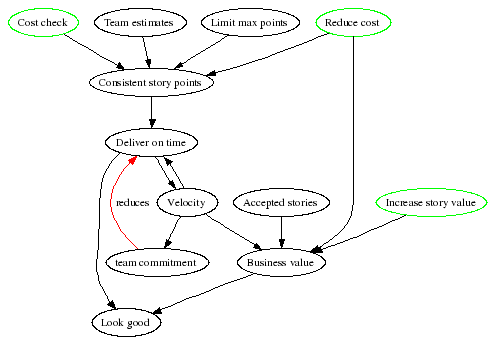If we reward people based on how high their velocity is, we’re in fact rewarding people who work hard. Or who game the the system. Assuming we trust the developers to be honest with their estimates (and there are plenty of forces helping them stay honest), what’s wrong with rewarding people who work hard?
Well, working hard is not The Goal of our team. Our goal is to create value for the people who pay for our hard work. If we want to optimize our system, we should be very clear about our goal and keep it firmly in mind.
Fortunately, value is pretty easy to measure and track IF each story has a value estimate by the customer. Just like we can measure the effort we put into the release by counting the story points of accepted stories, we can count the business value points of the accepted stories. And that’s exactly what we track on the burn up/down chart. As this chart is displayed where everyone can see it, we’re always reminded of our goal. Our goal is to:
- Create the highest possible business value in each release…
- …for the lowest possible cost per release
Therefore, we should be rewarded on the amount of value we release. As long as it isn’t released and used, the software’s value is zero.
“Hey, that’s not fair! We’re being rewarded based on value estimates made by the customer? What if the customers don’t know the value? What if they’re wrong? What if they game the system to lower the value? What if…?” Well… you do trust your customer to do a good job, to be honest, to be competent and to make an honest mistake from time to time, don’t you? If not, stop reading this blog and do something about it!
Like story point estimates, business value estimates should be consistent. Developers are allowed and encouraged to ask for the reasoning behind the value estimate. This nicely balances with the way the customer asks for the reasoning behind the story points estimates of the developers. But it’s ultimately the customer’s reponsibility to get the value right.
Customers and developers work together to maximize story value, like they do to minimize story cost. Before and during the planning game they should look critically at all the stories. Can we do this in a simpler way? Is there a way to get more value out of this story or to get the value sooner?

In this diagram we see that increasing velocity no longer makes you look good. Instead, producing more business value makes you look good. One of the ways to produce more business value is to genuinely increase the team’s velocity. Inflating story costs will not bring more value.
As in the previous diagram, if the team can deliver on time, their velocity will be a bit higher than planned. This means they will take on a little more work, commensurate with their increased velocity. But this reduces the odds that they will deliver on time next time, unless they find creative ways to increase their velocity.
We’ll see more about velocity in the next entry.

